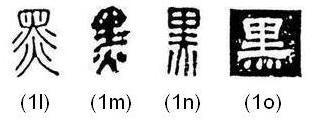It’s actually not fire, despite what the Shuowen (说文) says and what most native speakers believe. The character has nothing whatsoever to do with a fireplace, a chimney, or fire.
Let’s take a look. The following is essentially a summary of the chapter on 黑 in 《说文篆文讹形释例》 by Prof. Tu Chung-kao (杜忠诰). Prof. Tu is a famous calligrapher (probably best known for his book 《书道技法123》 and for his eccentric 草书) and respected paleographer (and my teacher), and his book 《说文篆文讹形释例》 contains an excellent analysis of the different processes of character corruption.
Note: The below was originally written by Ash Henson for our company’s blog, not by me.

黑 originally depicted a person with a tattooed face (image 1). Tattooing (墨刑) was a common punishment for committing a crime; one of the Five Punishments (五刑) in ancient China. A person receiving 墨刑 had the name of their crime tattooed on their body. If the tattoo was on the face, as it is here with 黑, it was called qíngmiàn [黥面].
Forms from the Spring and Autumn and Warring States periods sometimes added dots, such as can be seen in 2 and 3 above (note that in pre-Han dynasty scripts, character change and variation was extremely common and also varied by geographic area). The addition of dots here was to reinforce the notion of being marked by the 墨刑 tattoo.
The bottom part of 黑 was originally 大, which depicts a person. During the Eastern Zhou, 大 became more stylized and was written as follows:

Sorry for the weird numbering; these images come from another article.
Forms (1e) to (1h) are very typical ways of writing 大 during Warring States; and as can be clearly seen, 大 has already broken into two parts. Forms (1e) and (1g) are still almost a single piece, while forms (1f) and (1h) show a significant amount of separation. Let’s take a look at what caused this change.

Form (1i) is already very close to modern Chinese. (1k) is the typical Warring States form similar to forms (1e) to (1h) above. (1j) is a superimposition of (1i) in red, onto (1k) in black, showing that these forms are still essentially the same. The most likely cause for this change is convenience and ease of writing. Though (1k) has one more stroke, it’s actually easier to write and can be written in a more fluid motion (because the way the brush is lifted between strokes is less laborious). At the same time, we can also see how forms can get broken into smaller pieces.

The addition of the extra dots as seen in the forms 2 and 3 in the first image above, combined with writing 大 in two separate parts, like 1e-1k above, caused the bottom of 黑 to look very similar to 炎 yán. This is readily seen in (1l), which is the form that appears in the Shuowen.
In forms (1m) and (1n), the top 火 huǒ “fire” gets straightened out, while the bottom still resembles 火。 In (1n), the top parts looks like 里, while the bottom looks like a taller version of 灬, the form that 火 huǒ takes in modern characters when it appears at the bottom of a character. (1o) looks mostly like the modern form. Had 黑’s form not become corrupted, it would probably look like this now:

The original form (image 1 above), a single “piece” being corrupted into 1o, which has multiple parts, is an example of corruption by way of Disintegration (离析).
So, 黑 originally depicted a person with a tattooed face. Dots were added to emphasize the tattoo. The dots, along with the person’s body, separated over time and corrupted into 炎。 The top 火 “straightened out” and combined with the face to resemble 里, while the bottom 火 became 灬。 Thus, the 灬 in the modern form is simply a corruption of an earlier form, and actually has nothing to do with fire.
For more etymologically accurate character explanations based on the latest academic research, check out the Outlier Dictionary of Chinese Characters (and the forthcoming Outlier Kanji Dictionary):
